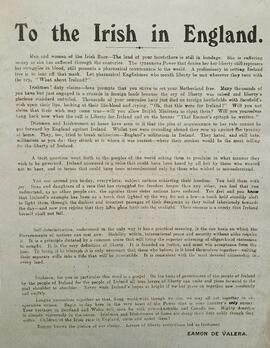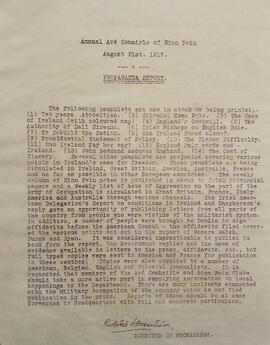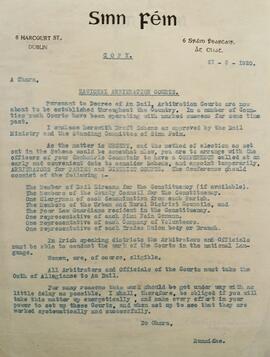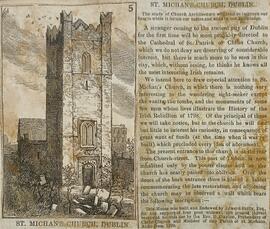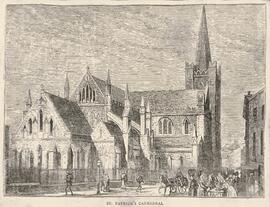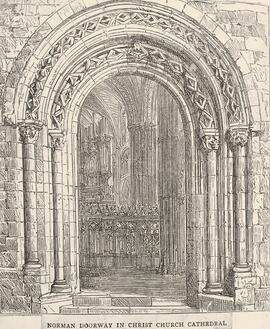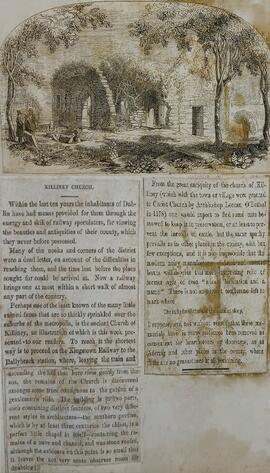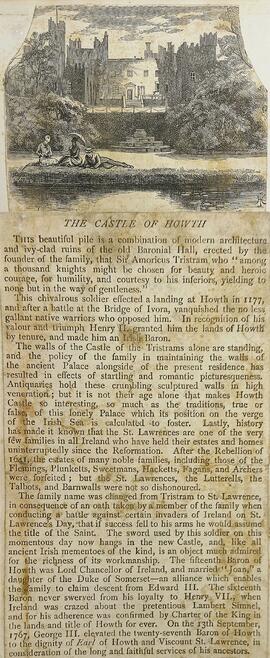Letter from Éamon de Valera addressed to Irish men and women in England asking them to support the movement for Irish independence. Text includes ‘Men and women of the Irish race – the land of your forefathers is still in bondage’; ‘Irishmen! duty claims – love prompts that you strive to set your Motherland free’; ‘Self-determination, understood in the only way it has a practical meaning, is the one basis on which the Governments of nations can rest now’. At foot of sheet: ‘Europe knows the justice of our claims. Lovers of liberty everywhere bid us Godspeed’.
A report on the publication of propaganda and publicity material prepared for the Sinn Féin Annual Ard Chomhairle in 1919. Several pamphlets publicising the Irish independence movement are mentioned.
Circular letter regarding the organisation and operation of National Arbitration Courts.
A clipping of a newspaper article on St. Michan’s Anglican Church on Church Street in Dublin. The article includes an illustration of the building. Reference is made to the internments of several individuals associated with the 1798 rebellion in the church’s vaults.
A clipping of an illustration of the exterior of St. Patrick’s Cathedral in Dublin.
A clipping of an illustration titled ‘Norman doorway in Christ Church Cathedral’ in Dublin.
A clipping of an article (with illustration) on the ruins of the eleventh-century Killiney Church (‘Cill Iníon Léinín’) in County Dublin.
A clipping of an article on Howth Castle in County Dublin. The article includes an illustration of the castle.
This section contains leases and deeds relating to the acquisition by the Capuchin friars of premises on Father Mathew Quay. The Quay is situated on a reclaimed marsh which was located outside the old city walls. Historically, the area was known by several names, some of which are used in the deeds described below including Island Nagay, Red Abbey Island and Marsh, and Morrison’s Island after a family which was prominent in the civic affairs of Cork in the eighteenth century. From about 1800 it was commonly known as Charlotte Quay before being renamed Father Mathew Quay in honour of the Capuchin friar and ‘Apostle of Temperance’. After the reclamation of the marsh in the eighteenth century, the area became an important merchant, commercial and industrial centre. John Henry Gamble, a notable businessman engaged in the provisioning trade, held leasehold interests in several of the premises on Charlotte Quay which were subsequently acquired by the Capuchins (see CA HT/2/1/1/5, CA HT/2/1/1/7, and CA HT/2/1/1/9). J.H. Gamble & Company was later acquired by the famous food provisioning company, Crosse and Blackwell Limited. Another prominent trader engaged in business on the Quay was Robert Warner, a master cooper and vintner. In 1875 Warner leased a substantial plot of ground on Charlotte Quay to Fr. Cherubini Mazzini OSFC for 750 years. This ground was subsequently used as the site for the present-day Holy Trinity Friary (See CA HT/2/1/2/13). The section also includes many legal documents covering negotiations between the Capuchins and Alicia Louisa Seward, a granddaughter of Robert Warner, for the outright purchase of the freehold of the property. This purchase was realized in 1951. The section also includes the lease made to Fr. Theobald Mathew OSFC in 1832 of a plot of ground on Morrison’s Island upon which Holy Trinity Church was subsequently built (see CA HT/2/1/2/10).
This section includes documents relating to the old Capuchin Friary, known as the South Friary, situated on Blackamoor Lane in Cork.
